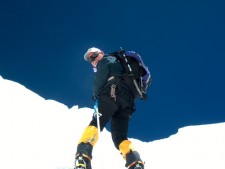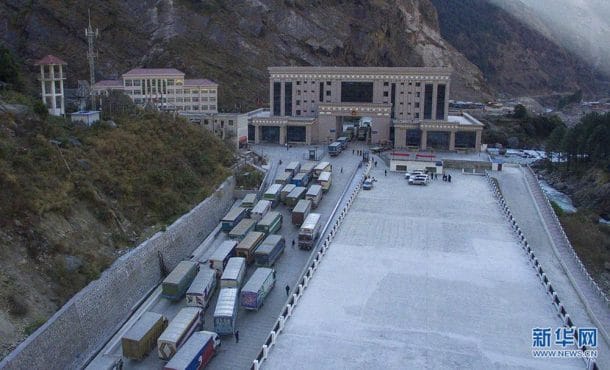
There is progress to report all around today. Teams are in Base Camp making their first trips into the Icefall. Others are finishing up their trek in the Khumbu and the North side teams have crossed the Chinese border and are starting the first of four nights en-route to the Chinese Base Camp.
Several teams including Adventure Consultants are getting close to South Base Camp and only have a couple more nights on the trek. Ang Dorge reports on the weather today:
The weather has changed, turning windy, medicine cloudy and colder than before. Flurries of snow flakes have come down this afternoon, and they sky is grey. Dorjee says this often happens when the Sherpa calendar changes into a new month.
Touching the Icefall
Wally Berg’s Berg Adventure small group made their first sortie into the Icefall. They reached an area known as the popcorn where the moving glacier has become quite jumbled and broken off looking like a field of popcorn. They used this climb to be introduced to crossing the ladders while wearing crampons, rope safety and the need to stay clipped in to the safety rope while crossing the ladders.
We went up about an hour, the consensus was that we’d reached close to 18,000 ft, but we stopped just before the “popcorn” section of the Icefall where the risk ramps up a bit. Back down to camp we came, stopping off for a cyber break, of course, in a safe place where we were finding the all-important 3G signal out of Gorak Shep for our smart phones.

Taking a deep breath, you kneel on one knee as you position your heavy climbing boot out front. You step onto the crampons, giving your foot a small twist, exerting slight pressure to seal the gap between tool and boot. With one quick move, you latch the heel lever into the boot groove.
Saying Goodbye
I often talk about the difficulty on those left back home while their loved one climbs. David Tait is going through a reverse sort of emotion. His wife and two sons accompanied him to Base Camp. They all arrived today at EBC and will fly out tomorrow. David’s thoughts on saying good bye to his family:
So tomorrow I repack their bags one last time. We will stand as a group next to BC helipad and wait for the rattle of the B3 as it enters the valley, its jet engine screaming in protest at the thinness of the air. With the freezing rotor wash pushing us into the ground and the engine barely coming off full power, I will hoist them aboard. With a last slam of the door and a brief salute to the oxygen-masked pilot I will pat the fuselage and watch helplessly as they vanish from my life for the next 6 weeks.
Dave Mauro once again has a post rich with descriptive words. What strikes me about this post is the absence of any big news, it is just a day in the life. And it sounded quite nice. Please read the entire post as it is the Blog of the Day
There was a haze of smoke filling the second floor hallway as Ty and I walked to our room last night. There was no concern of fire as the smell immediately identified itself as burning yak dung. Trust me on this; it has a distinctive odor. We debated opening the window in our room but decided this was just as likely to invite still more smoke in. Lacking other options, we sat on the floor eating hershey’s chocolate bars with almonds while watching episodes of The League on my laptop. Our room is at the far end of the Himalayan Hotel, abutting the Yak pasture. All night long the casual clang of metal bells spoke to the nocturnal grazing habit of the Yaks. Yet it was not unpleasant.
Climb On!
Alan
Memories are Everything




10 thoughts on “Everest 2013: First Steps into the Icefall”
Thank you for all the work that goes in to maintaining this blog and website.
Having just returned home from my EBC trek, it has been fun reading all the climbers’ dispatches as they have walked the same route. One thing that stands out is how pictures almost never give you a sense of the true scale of things. This is really true of the icefall which seemed to me much larger, steeper, and more intimidating than I expected. It must really get the adrenaline flowing going in there for the first time.
My Prayers are with Climbers & Sherpas for a Safe Summit & back home.
Hope Sagarmata Blesses them all with an enjoyable climbing season.
I will be watching their progress thru this blog.
Alan…I love reading what it’s like to get ready to climb in the morning and how there is a specific point where everyone puts on their crampons but why don’t climbers have a fixed rope for safety as they enter the icefall. I would think fixed ropes would be used as climbers enter the icefall so they don’t slip into a crevasse.
I am going to pak a small battery operated fan when I go so I can sleep with with all the yak dung smoke. I’m sure glad you tell us all these details so I can keep a list of things to take.
If the weather holds as you mentioned there may not be a gushing river in May in the lower icefall.
It has been another enjoyable journey in my mind thanks to your wonderful Everest memories.
Lynn, the fixed rope begins a bit higher up in the Icefall. There is no need for it at the precise beginning. Also, the crevasse danger at this point is very small as the Icefall has flatten-out. As for the yak dung smoke, it is mostly in the older teahouses and in the central dinning room where the single stove is located. The sleeping rooms are quite small and isolated. There can be smoke but at a much, much lesser level.
Really great to read and it seem that I was there in my dream .
Wish you a safe climb .
The climb starts ! I hope that everyone on the teams summit safely and without mishap ! May God give His Blessings to all the teams and protect them !
What a great description of what if feels like to “go over” from one world to the other – – total commitment to a foreign landscape.
thanks for your blog and website Alan ive read pretty much all your climbing blog and your photos also – this is the first everest season ill follow as it’s happening and your site is great for giving the context of what the climbers deal with
Thank you for the above article. I am a 62 year old woman who is fascinated with mountain climbing and have read many books on the subject. Although I will never experience Everest climbing myself, your article made me feel like I was actually there.
May Chomolungma be kind to the climbers this season
Sending prayers for safety and success for the sherpas
Comments are closed.